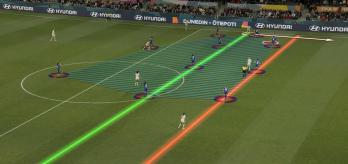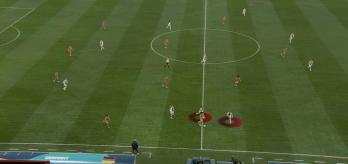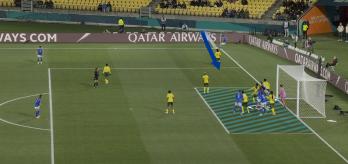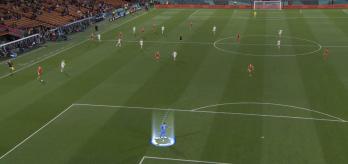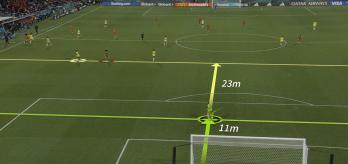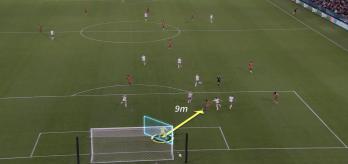In the FIFA Football Language, a line break is defined as when “a player progresses the ball and breaks one or more unit lines of the opposition team shape.”
Breaking lines reduces the number of opposition players available to defend and brings the attacking team closer to their opponent’s goal. There are a number of ways lines can be broken. The team in possession can break lines by playing through, around or over the opposition’s team units.
Per 30 minutes IP/OOP metric
When we calculate our in-possession and out-of-possession data, we do so using the “per 30 minutes in/out of possession” metric. In a game, the ball is generally in play for approximately 60 of the 90 minutes. Normalising the data to per 30 minutes, for both in and out of possession, provides a more accurate picture of what teams do during the time when they are with and without the ball, and removes any “possession bias”.
Figures 1 and 2 below emphasise the value of using these types of metrics. Spain on average had 60.5% possession control in their campaign (270 minutes in possession, 119 minutes out of possession), meaning they spent more of their total playing time with the ball than without it. Measuring Spain’s total number of direct pressures according to a 90-minute metric sees the tournament winners rank 27th out of the 32 participants, which could create a perception that La Roja performed poorly in this area.
However, when direct pressures are normalised to per 30 minutes out of possession, Spain rank sixth out of the 32 teams. This metric adds an important layer of context and is free from possession bias; it shows that, although it is true Spain ranked low for total number of direct pressures per 90 minutes, in the moments when they were out of possession they were one of the competition’s most frequent direct pressers.
Defensive structures – limited opportunities to play through
A key observation from this tournament was how the defensive organisation of teams affected the ability of attacking teams to break lines. In 2023, we had a very competitive tournament where the number of goals per game reduced, and the number of clean sheets increased. Our TSG observed how organised, narrow and compact defending teams were when defending, meaning it was difficult for attacking teams to find the space to break lines by playing through their team shape.
During FIFA Women’s World Cup 2023, the average team width of defending teams when in defensive blocks/press decreased compared to 2019. As we see in figure 3 below, the average team width when in a high block/press was 36.3m (0.6m narrower than in 2019); in a mid-block it was 36.0m (1.0m narrower) and in a low block, it was 33.7m (0.9m narrower). The closer defending teams got to their own goal, the narrower they became.
As a direct consequence of how narrow teams were, line breaks through opposition teams reduced by 22% compared to 2019.
According to Gemma Grainger, “This is an interesting development and shows how well organised teams were when they did not have the ball. It was difficult to break them down centrally as there was so little space available, so this meant that attacking teams had to find other solutions. Going straight through an opponent’s team is the most efficient way to progress the ball as it brings you more directly to goal but defending teams knew this and wanted to protect the central channel at all costs.”
Build-up in wide areas
As a direct consequence of the defensive structures they were facing, attacking teams needed to have more width in their build-up play to use, and expose, the space available in the wide areas. Statistically (per 30 minutes in possession), teams that were wider than their opponents in their “mid build-up” (build-up in the middle third of the pitch), won 76% of their matches, averaging a team width that was 2.5m wider than teams that lost games. In fact, 11 of the 12 knockout games that were won in normal time were won by the team that had a wider team width in mid build-up than their opponent.
Gemma Grainger explains, “Teams who were more successful in their attacking play had more width as they were building attacks and were intent on what they were doing. They knew the space was available in the wide areas and in creating the width, it helped in their attempts to stretch their opponent’s structure by dragging them into spaces they did not want to be. When the blocks shifted across, sometimes it opened gaps for the attacking team to go through and if they stayed central, it meant there was space in the wide area that could be exploited by going around.”
In the clips below, we see how some teams used width in their build-up play to create ways of breaking lines against their opponents’ defensive blocks. It is worth noting how patient teams are when building play in order to draw defenders out from their lines and create spaces for line-breaking passes.
Line breaks around opposition team shape
As we have seen, it is more difficult to play through the opposition’s team shape when their defensive block is narrow and compact. Space in wide areas presented a valuable alternative for attacking teams to break lines. To manage this, teams in possession of the ball would widen their shape during build-up and play around their opponent’s structure instead of playing into the congested central areas.
In this tournament, teams that completed more line breaks by going around their opposition won 60% of their games and averaged an additional 4.1 line breaks around per 30 minutes in possession than teams that lost. In fact, seven of the top-nine ranked teams for team width when attempting line breaks around, progressed to the knockout rounds and five of those seven progressed to the quarter-finals.
According to Gemma Grainger successful teams had clear attacking strategies to exploit the space around their opponent’s team shape.
“It was clear in this tournament that teams had really worked on different ways to break lines using wide areas and by going around their opponents. When watching the games, you could see how little space was available in the central channel of the pitch and attacking teams found solutions by keeping their width and giving wide defenders in the blocks decisions to make. This created opportunities to draw them out and isolate them and therefore creating spaces to break lines. As we see in the clips below, it also created opportunities for runners from midfield and other areas of the pitch to run in behind and receive from line-breaking passes around the opposition.”
Defensive line breaks
When attempting to create goal-scoring opportunities, defensive line breaks are the most dangerous of all as they often eliminate all defenders from the attacking situation except the goalkeeper. It is no surprise that teams who completed more defensive line breaks (per 30 minutes in possession) won 68% of their matches, completing an average of 3.6 more defensive line breaks than losing teams.
Winners Spain, a possession-based team, averaged 10.2 defensive line breaks per 30 minutes in possession. 40% of these were through their opponent’s team shape, 31% were around and 29% were over, reflecting the variety in La Roja’s build-up play and line-breaking ability. While Haiti, who proved to be very difficult to break down defensively and were very dangerous on the counter-attack, completed 64% of their defensive line breaks around, 29% through and just 7% over the opponent’s team shape.
According to Grainger, “We saw many different strategies for breaking the defensive line in this tournament, ranging from teams that had a patient build-up to disturb defenders to counter-attacking teams that broke defensive lines with early balls through, around or over high defensive lines. It was the variety and quality of the line-braking strategies that impressed me with teams having their own styles of play and ways of maximising the impact of their best players. The game awareness of players was really impressive. They knew exactly what they were doing and why they were doing it so there was real purpose to the play.”
“We also saw the importance of having players who can take defenders on and win 1v1s. This was a key success factor in weakening defensive blocks and creating overloads. Once a defender was beaten, the next defender had a decision to make, and this was important when breaking down blocks. In the clips below, we see examples of the different strategies used to break defensive lines,” she added.
The Finalists
When we look at the teams that performed the most line breaks per 30 minutes in possession, it is interesting to note that both finalists, Spain and England, ranked higher (67%) than all other teams (63%) in the competition for line break completion.
When we compare it to FIFA Women’s World Cup 2019™, the findings are similar. Both finalists, USA and the Netherlands, completed 74% of their attempted line breaks while other teams averaged just 60%. This demonstrates that the best teams in the tournament find different ways to break their opponent’s lines, whether they go through, around or over their team shape.
It is their ability to recognise the challenge posed by the defensive structures they face and find different solutions to complete line breaks that sets them apart from other teams.
Summary
While there is no best way to break lines, teams that demonstrated the capacity to complete line-breaking passes in different ways proved to be the most successful. In 2023, line breaks through the opposition team shape decreased significantly from 2019 as a result of the improved organisation and more compact nature of disciplined defensive blocks. Consequently, the proportion of completed line breaks around opponents increased in 2023 as attacking teams used width in their build-up to exploit the space available in the wide areas.
Based on their own playing styles and player attributes, teams used different strategies to break lines, but it is those with the greatest ability to find solutions in different situations, and to complete line breaks in a variety of ways, that found the ways to win.











